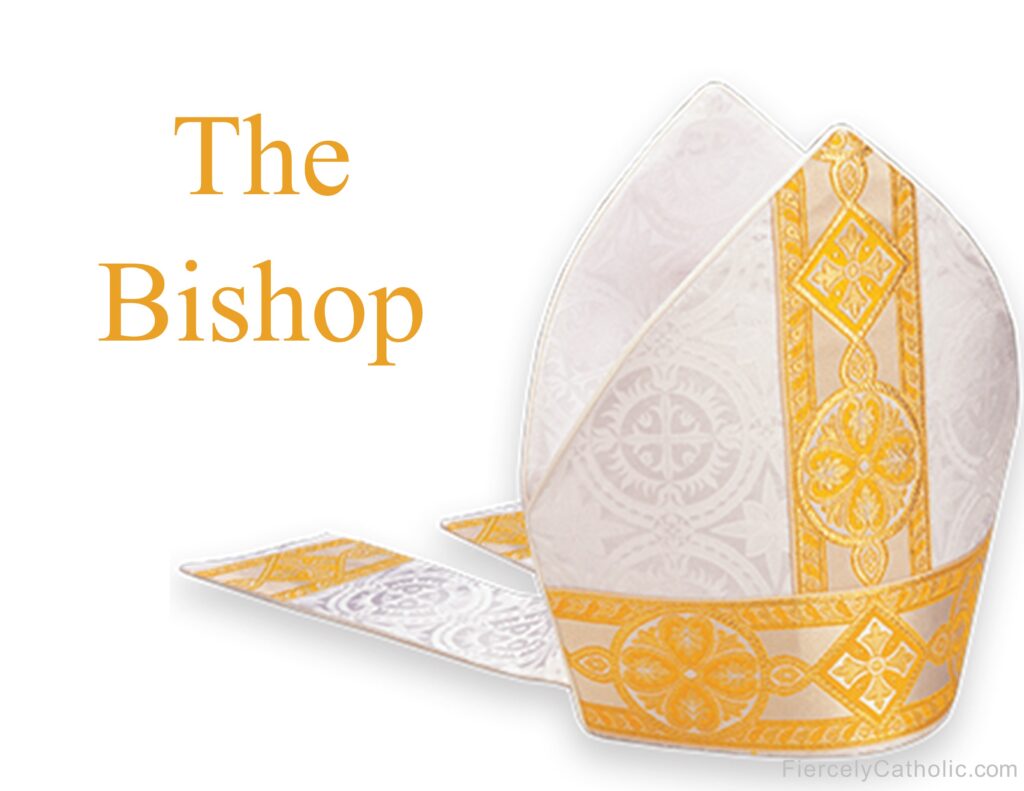
Today’s Catholic bishops are successors to the original Apostles chosen by Jesus.
From the Cathedral that holds the special chair of the bishop, he leads all of the Catholic churches in a geographic area known as a diocese. The bishop is assisted by the priests who pastor the churches within his diocese.
As a teacher, shepherd, and priest, the bishop has special clothing and other items to identify his role in the Church.
Having received the third and fullest level of Holy Orders, bishops administer all of the sacraments including Confirmation and ordain bishops, priests, and deacons.
An archbishop is the bishop of a main diocese and he receives a special woolen stole called a palium.
The bishop’s role is to teach, govern, and sanctify:
Ordained Catholic bishops follow in the footsteps of the Apostles:
This saying is trustworthy: whoever aspires to the office of bishop desires a noble task.
1 Timothy 3: 1
Bishops are called to imitate Jesus, the Good Shepherd:
Catholic bishops are in communion with the Apostles and each other:
Bishops, therefore, with their helpers, the priests and deacons, have taken up the service of the community, presiding in place of God over the flock, whose shepherds they are, as teachers for doctrine, priests for sacred worship, and ministers for governing. And just as the office granted individually to Peter, the first among the apostles, is permanent and is to be transmitted to his successors, so also the apostles’ office of nurturing the Church is permanent, and is to be exercised without interruption by the sacred order of bishops. Therefore, the Sacred Council teaches that bishops by divine institution have succeeded to the place of the apostles, as shepherds of the Church, and he who hears them, hears Christ, and he who rejects them, rejects Christ and Him who sent Christ.
Pope Paul VI, Lumen Gentium, November 21, 1964
Bishops are selected by the pope:
A bishop receives the fullness of the Sacrement of Holy Orders:
Likewise, it belongs to the sacramental nature of ecclesial ministry that it have a collegial character. In fact, from the beginning of his ministry, the Lord Jesus instituted the Twelve as “the seeds of the new Israel and the beginning of the sacred hierarchy.” Chosen together, they were also sent out together, and their fraternal unity would be at the service of the fraternal communion of all the faithful: they would reflect and witness to the communion of the divine persons. For this reason every bishop exercises his ministry from within the episcopal college, in communion with the bishop of Rome, the successor of St. Peter and head of the college. So also priests exercise their ministry from within the presbyterium of the diocese, under the direction of their bishop.
Catechism of the Catholic Church 877
The coat of arms is the mark of a bishop:
The role of the bishop is symbolized by what he wears:
The bishops vestments are rooted in history:
The Truth, Goodness, and Beauty of the Catholic Church
That all may have life to the full:
Share this page with friends and family to start a conversation about your faith.
Don’t miss a post. Learn more about the Catholic Church and strengthen your Catholic faith.
Find more Fiercely Catholic video issues here.
Subscribe here.


